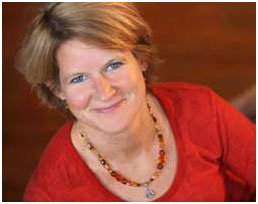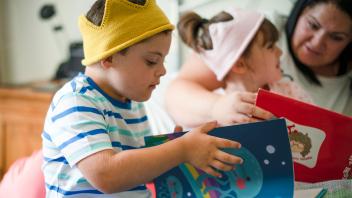At a recent conference, I had the chance to meet Elizabeth Rusch, the author of several of “Scientists in the Field” series (a consistently excellent series) — and discovered that I knew many of her other books. They range from picture books to narrative nonfiction with lots in between. I was intrigued and wanted to ask her more questions than time allowed.
So Liz Rusch agreed to an interview. Not surprisingly, she takes her work very seriously. What shines through with all of her well researched work is a respect for the subjects — and for readers.
I hope you enjoy meeting Liz and reading her books as much as I do! And don’t forget to browse our selected list of books by Elizabeth Rusch.

Your writing career started in copy editing for a magazine for adults. How did that launch your work as a professional writer?
I was hired straight out of college to be a research assistant for a new magazine called Teacher Magazine. When we began publication in 1989, I was made the copy editor. Since I didn’t have a degree in writing or journalism, I really learned about writing working with amazing writers and editors. I worked my way up from copy editor to managing editor and from writing short news items to writing features. It was a wonderful on-the-job education. When I moved to Portland, Oregon, in 1997, I had a folder full of clips and began working as a full-time magazine freelancer.
How did you come to writing nonfiction for young readers?
In the summer of 2000, I had an idea for a short story and a children’s book so I turned down all magazine assignments for three months to write them both. The children’s book, called Trina and the Tumbleweed, about a girl who somersaults on an adventure through the west with her friend Tumbleweed, was never published. (I still really like the story!) But at a writing conference I met an editor who admired the manuscript and I shared with her another idea I had for a children’s book. The conversation became my first published book, the middle-grade nonfiction title Generation Fix: Young ideas for a better world. Generation Fix tells the story of more than a dozen young people who saw a problem in their community and did something about. These true stories of young activists were almost like magazine features, so it was a great first book for me to write.
You’ve written a range of types of books for young readers — although I admittedly consider you mainly a writer of nonfiction, even in your picture books. First, how do you decide what topics you’ll write about? And are you aware of the form it will take (i.e., a picture book)?
Yes, I write both fiction and nonfiction for kids ages 2 and up to adult. One of the things I love most about being a writer is that I get to write about anything that interests me. I have written (or am writing about): Waves, jokes, mud, Mars, robots, volcanoes, art, music, history, invention, winter sports, cooking, parenting, tennis, the environment, superheroes, ventriloquism, and asteroids. Sometimes the topic immediately suggests a form and sometimes I have to play with the idea for a while before I find the form best suited to the topic. This is true for both fiction and nonfiction.
For instance, after watching my then-toddlers make mud paintings in the park, I had an idea for a story about a girl who gets her crayons taken away and has to discover color in the world around her. The age of the character and that developmental moment (love of crayons and early artistic exploration) immediately suggested a picturebook format. The idea eventually became A Day with No Crayons. The age group for my graphic novel Muddy Max: The Mystery of Marsh Creek was also clear from the beginning. The story of a boy bridling under his parents bizarre rules against muddiness who discovers that mud gives him superpowers seemed perfect for the middle-grade years when kid are just beginning to figure out their identity and test boundaries. But I had written two-thirds of the story as a novel before realizing that the visual and mystery elements really made it much better suited to the graphic novel form.
Likewise, for my nonfiction, the simple true story of why Pluto is no longer considered a planet seemed a natural picture book (The Planet Hunter: The Story Behind What Happened to Pluto), while the story of the Mars rovers could really be told in so many different ways. In fact, I wrote a picture book version for kids ages 2-6, a slightly more sophisticated book for kids ages 6-10, and an outline for a book for kids age 10 and up. I finally settled on telling the stories of Spirit and Opportunity though the eyes of the scientists who created, built and guided them, and the book become The Mighty Mars Rovers: The Incredible Adventures of Spirit and Opportunity, a Scientists in the Field book for kids ages 10 and up.
How do you research your topics? How does it change with the subject and the form? (You’ve written about historical figures — from musicians and scientists — and a range of subjects — everything from astronomy to earth science.)
Well, I start by reading everything on the planet about a topic (only a slight exaggeration). I especially love to dig up primary source materials such as letters, diary entries, newspaper articles and the like. So for my picture book biography of Wolfgang Mozart’s sister, For the Love of Music: The Remarkable Story of Maria Anna Mozart, I read through two huge volumes of Mozart family letters and a few other books that had materials from the time. I took a similar approach with Electrical Wizard: How Nikola Tesla Lit Up the World, but also read all the adult biographies on the genius inventor.
I also try to talk with experts. For The Planet Hunter, I interviewed Mike Brown, the astronomer who started searching for other planets in our solar system. Pluto’s dismissal from the planetary club was a result of Mike’s amazing discoveries so I wanted to hear the story in his own words. I also try to experience things related to the topic.
Two good examples come from books I’m working on now. For Mario and the Hole in the Sky, a picture book bio about a chemist who saved our planet, I actually got a chemistry kit and tried some of the experiments. For The Music of Life: Bartolomeo Cristofori and the Invention of the Piano, I traveled to Florence, Italy, and walked in the inventor’s footsteps with my family. I also visited the workshops of three Italian harpsichord and pianoforte builders.
You’ve written several books in the Scientists in the Field series. Tell us about the scientists you met. Did you get to go on site (at least for the Next Wave and maybe Eruption!)?
One of my favorite things about writing for this series is interviewing the scientists and spending time with them in the field. For The Mighty Mars Rovers, I didn’t get to go to Mars, but I did get to visit Mission Control at the Jet Propulsion Laboratory and interview the scientists and engineers working on the mission. For The Next Wave: The quest to harness the power of the oceans, I accompanied the inventors to their labs and workshops and to watched them test their devices in a tsunami basin and out at sea. For Eruption: Volcanoes and the Science of Saving Lives I tagged along as Andy trained volcanologist from Chile on Mount St. Helens and then I was invited to accompany a team lead by John Pallister to Indonesia five months after the catastrophic eruption of Mount Merapi. All of these experiences were incredible and were crucial to helping me bring these stories to life.
Talk about how illustrative material works with text in the different types of books you write (picture books, narrative nonfiction, and even your graphic novel).
Well for the most part, the publishing companies handle the illustrations for my books. (I have been lucky, though, that my editors have involved me in the choosing of illustrators and have invited me to review sketches and final art.)
One major exception is the graphic novel Muddy Max. I met illustrator Mike Lawrence at a local Comic Con and loved his work. We collaborated throughout the process.
Also, for two of my Scientists in the Field titles (The Mighty Mars Rovers and The Next Wave), I was responsible for curating the photography to accompany the text. While it takes ages to find high-quality photos and track down the rights, it is fun to think of these books as photo essays where the photos really tell a story, too.
Is objectivity possible when writing about informational topics? How does a nonfiction writer’s point of view show?
I don’t think objectivity is the point of all nonfiction writing. I think the readers of my books can get swept away by a true story because I am swept away by the story. When I write about the work of the scientists I admire, it is because I passionately admire their work. My interest, passion and engagement in a topic absolutely shape my books, and I have no problem with this being rather obvious to the reader.
Would you rather read a bunch of facts about volcanoes or explore the wonder of the creative force of volcanoes (Volcano Rising) and be the edge of your seat as you read about scientists struggling to save whole villages from the destructive power of volcanoes (Eruption)? Either way you will learn about volcanoes, but when I put my heart, my passion, and my point of view into a book, I hope readers will come away with much more than the facts.
Is there anything that I haven’t asked you that you’d like to add?
Parents, teachers, and readers can learn much more about my work at my website . On my website, I have wonderful teacher resources related to my books, including discussion questions, hands-on activities, and Common Core guides. I also offer information about my school visits.
Please like my facebook page and join me on twitter .
If anyone would like to get my enewsletter, which I send out roughly two to three times a year, please email me at Elizabeth Rusch.
About the Author
Reading Rockets’ children’s literature expert, Maria Salvadore, brings you into her world as she explores the best ways to use kids’ books both inside — and outside — of the classroom.

